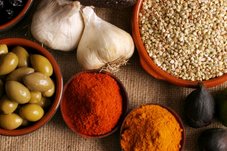As we enter the time of year, giving and good will is ever present in our thoughts. As master gardeners we share a love of plants and of good tilled earth. We are stewards of the land committed to ecologically sound conservation through managing soil, water, insect and plant resources. We strive to act in a manner that does not pollute the water or destroy pollinators, beneficial insects or soil microorganisms that provide essential ecosystem services. While being stewards of these precious resources we seek to leave a small unobtrusive footprint behind. This, is it not, a gift we give to our families, to our community and to our precious Terra Madre.
As stewards it is also vital that we recognize the importance of crop genetic diversity. Nearly two thirds of the distinctive seeds and breeds that fed America have vanished. Sixty three percent of native, American food crop varieties have disappeared from cultivation since European arrival on this continent. These foods that are being lost are the results of thousands of years of adaptation and selection in diverse ecological niches around the world. The loss of the diversity of our world’s food crops is eroding at an accelerating and unprecedented rate. As gardeners we must comprehend the true scope of our garden heritage, how much is in immediate danger of being lost forever, and how we can preserve this heritage for future generations by saving seed and heirloom plant varieties.
Each plant variety is genetically unique, developing resistances to the diseases and pests with which it evolved. These old varieties are used by modern plant breeders to breed resistance into modern crops that are incessantly being attacked by precipitously evolving disease or pests. Without this infusion of genetic diversity food production is at risk from infestations and epidemics.
Does anyone remember the Marshall strawberry for which Oregon was once so well known? This sweet red berry was once the backbone of the northwestern berry industry. The only hint of this remarkable strawberry exists at the USDA’s Germplasm Repository in Corvallis in the form of a single clone.
Just what is the impact of this genetic erosion? World renowned plant collector, the late Jack Harlan, author of Crops and Man while Professor of Plant Genetics at University of Illinois at Urbana, has written, “These resources stand between us and catastrophic starvation on a scale we cannot imagine. In a very real sense, the future of the human race rides on these materials. The line between abundance and disaster is becoming thinner and thinner, and the public is unaware and unconcerned. Must we wait for disaster to be real before we are heard? Will people listen only after it is too late?”
Once upon a time see saving was a necessity. Farmers and gardeners selected the best seeds from harvest so there would be seed for planting in subsequent years. As they do not exist in the wild, domesticated crops depend on an intimate relationship with humans.
Over the eons, traditional farmers have saved seed from plants that exhibited a diversity of favorable traits to them or their communities such as maturing before frost, sweeter taste, and resistance to specific insects or diseases.
The rise of commercially available seed resulted in a trend away from seed saving. Farmers and gardeners purchase new seeds every year resulting in a loss of many seed varieties. Due to a growing concern regarding the loss of many varieties as commercially available seeds a grass roots movement began dedicated to seed saving. In 1975 Kent and Diane Whealy founded the Seed Savers Exchange dedicate to the continuation and preservation of heirloom fruit and vegetable varieties and is the single most effective food crop conservation non-profit in history. The SSE yearbook annually offers members 12,000 varieties of heirloom fruits and vegetables. As a member and contributor to the Seed Savers Exchange, I heartily recommend that every gardener become a member. There is also a flower and herb exchange as well for those of you not into food gardens.
Do I practice what I preach? Well I’m not just preaching to the choir. So far I have managed to save and perpetuate two varieties of garlic, two shallots, five snap beans, one dry bean, three lettuces, one melon, one winter squash, one chile pepper, one Jerusalem artichoke, three tomatoes and 14 apples. Saving seed (or corms, or tubers, or cuttings) is fun and rewarding as well as not being particularly difficult in most cases once you understand the parameters. The most comprehensive and easily understandable book that I have found on the subject is Seed to Seed by Suzanne Ashworth available through Seed Savers Exchange. In some cases it is a matter of trial and error to determine what varieties you like and what works for you. The school of hard knocks is sometimes the best teacher.
Local, regional, national and global food security depends on plant diversity as well as our stewardship. Through our ongoing stewardship and dedication we can preserve and pass on these precious gifts for future generations. This then is truly a gift that keeps on giving.
Sources:
Seed Savers Exchange; http://www.seedsaversexchange.org/
Renewing America’s Food Traditions (Gary Paul Nabhan and Ashley Road Center for Sustainable Environments at Northern Arizona University on behalf of the RAFT Coalition)
Slow Food USA: http://www.slowfoodusa.org/
Native Seed/Search: http://www.nativeseeds.org/
